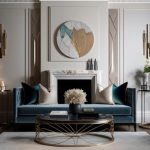Because sometimes you don’t know where to start when decorating your home, muraledesign here to help you understand interior design basics. If you aren’t design minded, mastering the principles of interior design can be tricky and we want to make it easier to learn interior design basics.
Take in these tips and tricks from our decorators to take advantage of these interior design principles – or interior design for dummies, if you will.
PLAN FOR PRACTICALITY
One of the principles of interior design is practicality. There’s no point in spending all your time designing a gorgeous room if your furniture doesn’t fit and you can’t walk through the space between your table and the door. The best place to start is with the interior design basics – work out whether your furniture fits in your room and where. Think about the layout of your furniture based on what you want from the room and what items you make the most use of.
Situating a stylish chair in front of your fireplace because it looks nice doesn’t work if you don’t sit on that chair, and having your coffee table at the other end of the room from the couch, because it fits in the space, isn’t realistic or practical. A simple way to figure out what fits in your room and where is to measure everything and draw it out to scale; you can then move things around and see what fits where. This is an essential on our list for interior design for dummies for good reason; you should spend plenty of time on this initial stage. Once you get more confident with this stage you can start to include things like artwork placement. This will help the Brisbane picture hanging service you choose when it comes to the installation of your art.
PUT PEN TO PAPER
It can be hard to visualize exactly what your room is could look like with so many ideas in front of you. One of the basics of interior design is to decorate your walls with some attractive wall art sets based upon your personality, interest, and matching with your furniture. Also, you can collect some ideas on paper (or on your computer) and create a visualization of your home. Invest in a set of colored pencils so you can compare colors, wallpaper designs, and the colors of your furnishings.
This is also a great way to figure out what looks good and what doesn’t. From here, you can navigate color schemes and fabrics to come up with the ultimate design for your home.
CREATE A MOOD BOARD
When you soak up so many ideas, it can be hard to keep track of them all. An easy and effective way to organize your ideas together is with a mood board to perfect for your interior design concepts. You don’t have to do it the old-fashioned way and cut out pictures from magazines and tape samples of fabric to a board, you can use apps like Pinterest to create a space in which you can keep your ideas together and refer back to them later (interior design basics have moved online).
Having all your ideas in one space like this helps you decide on things you also don’t like – this way you can see your tastes and ideas change and you can get rid of the ideas you don’t like.
TAKE INSPIRATION FROM OTHERS
If you aren’t an interior designer, look at the designs of people who are for inspiration. One of the best ways to get inspired is to look at the spaces other people are designing, so you can see what is on trend at the moment while making the most of their interior design concepts. If you aren’t blessed with natural interior design skills, it can be hard to understand when you are trying to get to a grip on interior design basics.
Take inspiration from interior design magazines and interior design sites as people share their designs to inspire you and to show you what can be done.
TAKE YOUR TIME
One of the fundamentals of interior design is to take your time – when you are designing your home there is no rush, you don’t have a tight schedule and it doesn’t need to be done in one swoop, or overnight. Rushing this process is a sure-fire way to end up with a home you aren’t happy with.
Don’t put pressure on yourself to have a finalized design in one week, you aren’t a trained interior designer and you’re a novice at understanding the principles of interior design. Getting it done right is more important than getting it done quickly and being happy with a home you are going to live in for years is worth it, even if it takes a few weeks longer than you wanted it to.
INJECT YOUR PERSONALITY
When you are designing your home, it’s easy to end up with rooms that look they belonged to anyone; you’ve followed interior design principles, but your room still doesn’t reflect you or your personality. Think about what you want people to think and see when they walk into your home and consider what your home says about you.
Whether you are a cool, calm and collected person or someone full of life and personality, evoke that feeling into the design of your home. Come up with a list of 5 words to describe your space and let your imagination flow.
THE DEVIL IS IN THE DETAILS
Details make a huge difference, whether that’s the style of the stitching on your curtains, the patina of your wood flooring, or a lovingly handcrafted piece of furniture you have in a room. Details are what brings a room together and are what makes it feel like ‘your’ room rather than just ‘a’ room and are another of the fundamentals of interior design.
It can be stylish lamp in one corner, a plant next to your fireplace or the collectibles styled on your shelving unit. Dedicate time to realizing the details of every room in your home. Things like matching the color of your cushions to the color in one of your pieces of art, or a complementary pattern on a rug which looks great against your couch, can make all the difference. Keep your eye out for quality products and put thought into where everything is going to go as details make all the difference.




